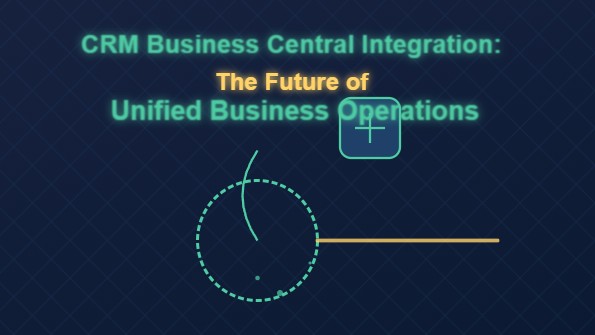In today’s digitally driven world, where speed, precision, and personalization define business success, disconnected systems are a silent killer of productivity. Enter CRM Business Central Integration — a technological bridge that unifies front-end customer relationship management with back-end financials and operations.
This isn’t just about syncing data. It’s about empowering organizations with real-time, holistic visibility, enabling smart decisions, accelerating workflows, and delivering seamless customer experiences.
Let’s unpack how CRM and Microsoft Dynamics 365 Business Central work together, why the integration matters, and how to implement it strategically to unlock maximum business value.
Table of Contents
🔍 What is CRM Business Central Integration?
At its core, CRM Business Central Integration refers to the process of connecting a CRM system (like Dynamics 365 Sales or Salesforce) with Microsoft Dynamics 365 Business Central, a powerful cloud ERP solution.
It creates a synchronized environment where sales, finance, customer service, and operations can collaborate based on shared, real-time data.
Imagine this:
A sales rep closes a deal in CRM → automatically creates a customer record in Business Central → triggers invoicing, order processing, and inventory checks—no manual handoffs, no data duplication.
🚀 Why Integrate CRM with Business Central?
Here’s why thousands of businesses are choosing integration:
✅ Eliminate Data Silos
Disconnected systems mean scattered information. Integration ensures a single source of truth across departments.
✅ Boost Operational Efficiency
Reduce manual data entry, eliminate errors, and speed up sales-to-cash cycles by automating handoffs between sales and finance.
✅ Enhance Customer Experience
Customer service can access order history, invoices, and delivery statuses without switching systems—leading to faster, smarter support.
✅ Improve Financial Accuracy
Sales orders and customer details are instantly reflected in your ERP, ensuring accurate billing, inventory, and forecasting.
✅ Enable Better Decision-Making
Executives get cross-functional reports combining CRM metrics (like pipeline size) with ERP metrics (like receivables or profitability).
🔧 Key Integration Scenarios
Let’s explore real-world integration use cases between CRM and Business Central:
1. Customer Sync
-
CRM leads or accounts are converted into Business Central customers automatically.
-
Updates in one system reflect in the other.
2. Product & Price List Sync
-
Product catalogs and pricing structures in Business Central are visible in CRM for quoting and order creation.
3. Quote-to-Order Workflow
-
Sales reps generate quotes in CRM.
-
Upon approval, quotes become sales orders in Business Central—no re-entry needed.
4. Invoice & Payment Visibility
-
Invoices generated in Business Central are visible in CRM.
-
Sales teams can track payment status directly from CRM.
5. Inventory Visibility
-
CRM users can see real-time stock levels and delivery timelines during the sales process.
🏗️ Architecture Overview
Here’s how the architecture typically looks:
[CRM System] ←→ [Integration Middleware / Connector] ←→ [Business Central]
Popular integration approaches:
-
Native Integration (Microsoft-first stack)
-
Dynamics 365 Sales ↔ Dynamics 365 Business Central
-
Uses Dataverse or Power Platform as the data layer
-
-
Middleware (for cross-platform)
-
E.g., Salesforce + Business Central via tools like KingswaySoft, Scribe, or Zapier
-
-
Custom API Integration
-
Leverages Business Central’s OData APIs or Web Services
-
📦 Pre-Built Integration Tools
For faster deployment, many businesses use ready-to-go solutions:
| Tool | Features |
|---|---|
| Microsoft’s Native Integration | Direct sync between Dynamics apps, supports bidirectional data flows |
| Scribe (TIBCO) | Visual data mapping, supports complex workflows |
| KingswaySoft (SSIS) | Robust ETL tool for SQL Server, high control over transformation |
| Codeless Platforms BPA | Workflow automation with built-in CRM/ERP connectors |
| Zapier / Integromat | Lightweight integrations, suitable for small businesses |
⚙️ Steps to Implement CRM–Business Central Integration
A successful integration project involves more than just data mapping. Here’s the roadmap:
1. Define Business Objectives
-
What’s the goal? Faster sales-to-cash? Better customer visibility?
Establish KPIs before choosing a tool.
2. Map Data Models
-
Align CRM entities (Leads, Accounts, Quotes) with Business Central objects (Customers, Items, Orders, Invoices)
3. Choose Integration Method
-
Native vs middleware vs custom—depends on budget, scalability, and tech stack.
4. Configure Sync Rules
-
Decide direction of sync (one-way vs bidirectional)
-
Set frequency (real-time vs scheduled batch)
5. Test in Sandbox
-
Use test environments to validate mappings, handle edge cases, and simulate workflows.
6. Go Live & Monitor
-
Roll out in phases, enable alerts/logs, and train users to handle exceptions.
🔐 Security & Governance Considerations
Security and compliance must be embedded into every integration project:
-
Data Privacy: Ensure PII and financial data is encrypted and access-controlled.
-
Audit Trails: Maintain logs of data syncs, transformations, and access points.
-
Error Handling: Design retry logic and alerting for failed syncs.
-
Role-Based Access: Ensure only relevant data is visible to each role (e.g., sales can’t see supplier invoices).
🧠 Advanced Features with Power Platform
For Microsoft-centric environments, using the Power Platform can elevate integration:
-
Power Automate: Create flows that trigger actions across CRM and Business Central
-
Power BI: Build unified dashboards combining CRM pipelines + ERP financials
-
Power Apps: Create custom frontends that pull data from both systems
-
Dataverse: Use as a shared data model for seamless sync
💼 Industry Use Case Examples
Manufacturing
-
CRM manages B2B leads, Business Central handles production orders.
-
Sales team can check stock and delivery ETA live.
Professional Services
-
New projects created in CRM become jobs in Business Central.
-
Finance team tracks billable hours directly from CRM activity logs.
Wholesale/Retail
-
Sales reps create quotes in CRM, convert to Business Central orders.
-
Inventory updates flow back to CRM daily.
📈 Measuring Success Post-Integration
After integration, track these metrics to evaluate ROI:
| KPI | Why It Matters |
|---|---|
| Sales-to-Cash Time | Integration should reduce cycle time |
| Data Accuracy | Fewer duplicate or outdated records |
| Support Response Time | Improved context leads to faster case resolution |
| System Downtime | Stable sync processes improve uptime |
| Employee Satisfaction | Less manual entry = happier teams |
🧠 Final Thoughts: From Fragmented to Fluent
CRM–Business Central Integration is more than a technical task—it’s a business transformation enabler.
It aligns sales, operations, and finance on a single customer-centric thread, turning scattered insights into strategic foresight. Whether you’re using Dynamics 365 end-to-end or integrating Salesforce with Business Central, the result is the same: cohesive, efficient, data-driven operations.
In an age where agility defines winners, integrated systems are not just smart—they’re essential.




